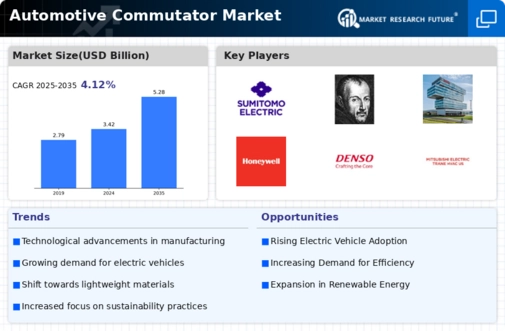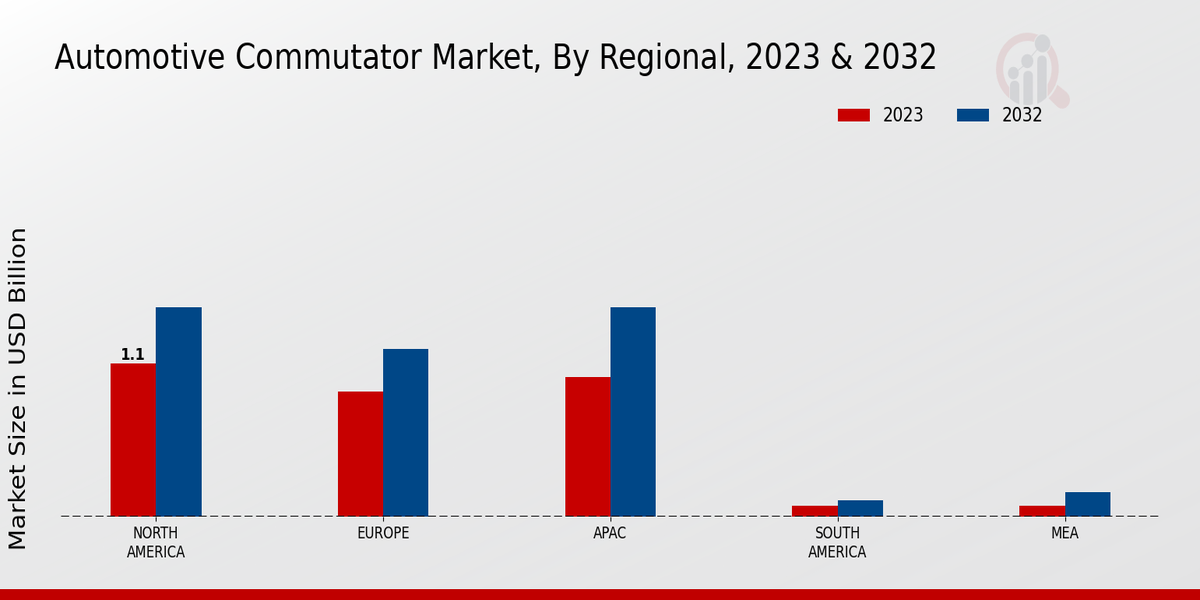Market Growth Projections
The Global Automotive Commutator Market Industry is poised for substantial growth, with projections indicating a market size of 3.42 USD Billion in 2024 and an increase to 5.28 USD Billion by 2035. This growth trajectory reflects a compound annual growth rate (CAGR) of 4.03% from 2025 to 2035, driven by various factors including technological advancements, regulatory support, and the rising demand for electric and hybrid vehicles. These projections highlight the dynamic nature of the market and the potential for innovation and investment in automotive commutator technologies.
Growing Demand for Electric Vehicles
The increasing adoption of electric vehicles (EVs) is a pivotal driver for the Global Automotive Commutator Market Industry. As manufacturers pivot towards sustainable mobility solutions, the demand for efficient commutators that can handle the unique requirements of electric drivetrains is surging. In 2024, the market is projected to reach 3.42 USD Billion, reflecting the industry's shift towards electrification. This transition necessitates advanced commutator designs that enhance performance and reliability, thereby propelling market growth. The global push for reduced emissions further amplifies this trend, as automakers seek to integrate innovative technologies into their EV offerings.
Rising Production of Hybrid Vehicles
The surge in hybrid vehicle production is a crucial driver for the Global Automotive Commutator Market Industry. Hybrid vehicles, which combine internal combustion engines with electric propulsion, require specialized commutators to optimize performance. As manufacturers ramp up production to meet consumer demand, the need for high-quality commutators becomes increasingly pronounced. This trend is expected to contribute significantly to market growth, with projections indicating a market size of 3.42 USD Billion in 2024. The hybrid vehicle segment's expansion reflects a broader industry shift towards versatile powertrains, further solidifying the importance of advanced commutator technologies.
Increased Investment in Automotive R&D
Investment in research and development (R&D) within the automotive sector is driving advancements in the Global Automotive Commutator Market Industry. As companies strive to enhance vehicle performance and efficiency, R&D initiatives focus on developing innovative commutator solutions that meet emerging market demands. This emphasis on innovation is likely to result in the introduction of new materials and designs that improve the functionality of commutators. The anticipated growth trajectory, with a CAGR of 4.03% from 2025 to 2035, suggests that ongoing investment in R&D will play a pivotal role in shaping the future landscape of the automotive commutator market.
Regulatory Support for Sustainable Practices
Regulatory frameworks promoting sustainability are shaping the Global Automotive Commutator Market Industry. Governments worldwide are implementing stringent emissions standards and incentivizing the adoption of green technologies. This regulatory support encourages manufacturers to invest in innovative commutator solutions that comply with environmental standards. As a result, the market is likely to experience robust growth, driven by the need for components that align with these regulations. The anticipated compound annual growth rate (CAGR) of 4.03% from 2025 to 2035 underscores the potential for expansion in this sector, as companies adapt to evolving compliance requirements.
Technological Advancements in Commutator Design
Technological innovations in commutator design significantly influence the Global Automotive Commutator Market Industry. Enhanced manufacturing techniques, such as precision engineering and the use of advanced materials, contribute to improved performance and durability of commutators. These advancements allow for better heat dissipation and reduced wear, which are critical for high-performance applications. As the automotive sector increasingly demands higher efficiency and reliability, the market is expected to grow, with projections indicating a rise to 5.28 USD Billion by 2035. This growth is indicative of the industry's commitment to integrating cutting-edge technologies into automotive components.













